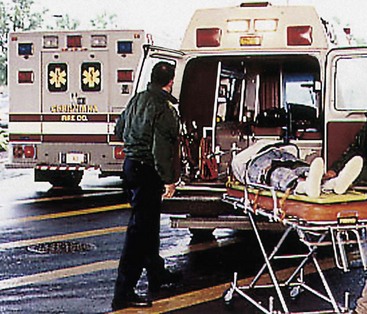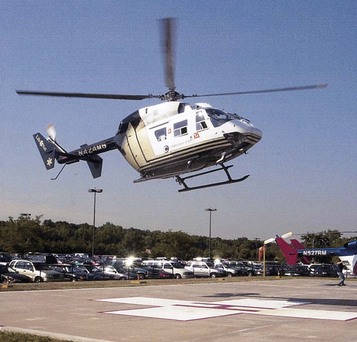Chapter 10 Concepts of Emergency and Trauma Nursing
Safe and Effective Care Environment
1. Describe the emergency department (ED) environment, including vulnerable populations and interdisciplinary team members.
2. Identify the roles and responsibilities of the health care team members in the ED.
3. Plan and implement best practices to maintain staff and patient safety in the ED.
4. Explain selected core competencies that nurses need to function in the ED.
5. Triage patients in the ED to prioritize the order of care delivery.
6. Prioritize resuscitation interventions based on the primary survey of the injured patient.
7. Describe the role of the ED nurse in providing support for families after the death of a loved one.
http://evolve.elsevier.com/Iggy/
Answer Key for NCLEX Examination Challenges and Decision\xE2\x80’Making Challenges
Review Questions for the NCLEX® Examination
The demand for emergency care in the United States is growing rapidly. Emergency departments (EDs) function as safety nets for communities of all sizes by providing services to both insured and uninsured patients seeking medical care. They are also responsible for public health surveillance and emergency disaster preparedness. Some hospital-based emergency departments also provide observation, procedural care, and employee health services (Moskop et al., 2009). The role of the ED is so vital that the Centers for Medicare and Medicaid Services (2010) has a process for designating small rural facilities of 25 inpatient beds or fewer as critical access hospitals if they provide around-the-clock emergency care services 7 days per week. Critical access hospitals are considered necessary providers of health care to community residents that are not close to other hospitals in a given region.
Because of the multi-specialty nature of the environment, EDs play a unique role within the U.S. health care system. More than 119 million people visit the ED each year (Centers for Disease Control and Prevention [CDC], 2010). The demand for emergency care has greatly increased over the past 15 years, and the health care consumer has higher expectations; however, the capacity to provide necessary resources has not kept pace in most systems. Emergency department crowding occurs when the need for care exceeds available resources in the department, hospital, or both (Howard, 2009).
The Emergency Department Environment of Care
Demographic Data
Considerations for Older Adults
Older adults usually visit the ED because of worsening of an existing chronic condition or because the condition affects their ability to perform ADLs. Many older adults seek ED services when they are seriously ill because they do not want to “bother” their health care provider with phone calls (Nolan, 2009).
Special Nursing Teams
Many EDs have specialized teams that deal with high-risk populations of patients. One example is the forensic nurse examiner team. Forensic nurse examiners (RN-FNEs) are educated to obtain patient histories, collect forensic evidence, and offer counseling and follow-up care for victims of rape, child abuse, and domestic violence—also known as intimate partner violence (IPV) (Scales et al., 2007). They are trained to recognize evidence of abuse and to intervene on the patient’s behalf. Forensic nurses who specialize in helping victims of sexual assault are called sexual assault nurse examiners (SANEs) or sexual assault forensic examiners (SAFEs).
Interdisciplinary Team Collaboration
Prehospital Care Providers
Prehospital care providers are typically the first caregivers that patients see before transport to the ED by an ambulance or helicopter (Fig. 10-1). Local protocols define the skill level of the EMS responders dispatched to provide assistance. Emergency medical technicians (EMTs) offer basic life support (BLS) interventions such as oxygen, basic wound care, splinting, spinal immobilization, and monitoring of vital signs. Some units carry automatic external defibrillators (AEDs) and may be authorized to administer selected drugs such as an EpiPen or nitroglycerin based on established medical protocols. For patients who require care that exceeds BLS resources, paramedics are usually dispatched. Paramedics are advanced life support (ALS) providers who can perform advanced techniques, which may include cardiac monitoring, advanced airway management and intubation, establishing IV access, and administering drugs en route to the ED (Fig. 10-2).

FIG. 10-2 Prehospital providers take a patient from the ambulance to be brought into the emergency department.
Inpatient Unit Staff
The emergency nurse’s interactions extend beyond the walls of the ED. Communication with staff nurses from the inpatient units is necessary to ensure continuity of patient care. Providing a concise but comprehensive report of the patient’s ED experience is essential for the hand-off communication process and patient safety (Mascioli et al., 2009). Information should include the patient’s:
• Situation (reason for being in the ED)
• Assessment and diagnostic findings
• Transmission-based precautions needed
The Joint Commission’s National Patient Safety Goals (NPSGs) (2010) require hospitals and other health care agencies to use a standardized approach to hand-off communications to prevent errors that are caused by poor or inadequate communication. Many agencies use the SBAR method (situation, background, assessment, response) or some variation of that method to ensure complete and clearly understood communication. Chapter 1 discusses the SBAR technique in more detail.
Staff and Patient Safety Considerations
In the emergency department (ED) setting, staff and patient safety are major concerns (Chart 10-1). Staff safety concerns center on the potential for transmission of disease and on personal safety when dealing with aggressive, agitated, or violent patients and visitors.
Chart 10-1 Best Practice for Patient Safety & Quality Care
Maintaining Patient and Staff Safety in the Emergency Department
| SAFETY CONSIDERATION | INTERVENTIONS TO MINIMIZE RISK |
|---|---|
| Patient identification | |
| Injury prevention for patients | |
| Risk for errors and adverse events | |
| Injury prevention for staff |
Staff Safety
Critical Rescue
Many EDs have at least one security guard present at all times for immediate assistance with these situations. Metal detectors may be used as a screening device for patients and visitors who are suspected of having weapons. Strategically located panic buttons and remote door access controls allow staff to get help and secure major ED or hospital entrances. The triage reception area—a particularly vulnerable access point into the ED—is often designed to serve as a security barrier with bullet-proof glass (Laskowski-Jones et al., 2005). Hospitals may even employ canine units made up of specially trained officers and dogs to patrol high-risk areas and respond to handle threatening situations (Johnson & Parker, 2009).
Patient Safety
In addition to concerns about staff safety, some of the most common patient safety issues are:
Correct patient identification is critical in any health care setting. All patients are issued an identification bracelet at their point of entry of the ED—generally at the triage registration desk or at the bedside if emergent needs exist. For patients with an unknown identity and those with emergent conditions that prevent the proper identification process (e.g., unconscious patient without identification, emergent trauma patient), hospitals commonly use a “Jane/John Doe” or another identification system. Whatever method is used, always verify the patient’s identity using two unique identifiers before each intervention and before medication administration per The Joint Commission’s 2010 National Patient Safety Goals. Examples of appropriate identifiers include the patient’s birth date, agency identification number, home telephone number or address, and/or Social Security number.
Action Alert
Older adults who are on beds or stretchers should always have all siderails up and the bed or stretcher in the lowest position. Access to a call bell or light is especially important; instruct the patient to call for the nurse if assistance is needed rather than attempt independent ambulation. Many older adults have difficulty adjusting to the noise and pace of the ED and/or have illnesses or injuries that cause delirium, an acute confusional state. Reorient the patient frequently, and re-assess mental status. Undiagnosed delirium increases the risk for mortality for older adults who are admitted to the hospital. Assess the need for a family member, significant other, or sitter to stay with the patient to prevent falls and assist with reorientation. Additional safety strategies are listed in Chart 10-1.
Protecting skin integrity also begins in the ED. Emergency nurses need to assess the skin frequently and implement preventive interventions into the ED plan of care, especially when caring for older adults or those of any age who are immobilized. Interventions that promote clean, dry skin for incontinent patients, mobility techniques that decrease shearing forces when moving the immobile patient, and routine turning help prevent skin breakdown. Chapter 27 describes additional nursing interventions for preventing skin breakdown.
To reduce error potential, the emergency nurse makes every attempt to obtain essential and accurate medical history information from the patient, family, or reliable significant others as necessary. When dealing with patients who arrive with an altered mental status, a quick survey to determine whether the person is wearing a medical alert bracelet or necklace is important to gain medical information. In addition, a two-person search of patient belongings may yield medication containers; the name of a physician, pharmacy, or family contact person; or a medication list. In this case, the nurse serves as a detective to find clues, which may not only promote safety but also help determine the diagnosis and influence the overall emergency treatment plan. Automated electronic tracking systems are also available in some EDs to assist staff in identifying the location of patients at any given time and in monitoring the progress of care delivery during the visit. These valuable safety measures are especially important in large or busy EDs with a high population of older adults (Laskowski-Jones, 2008).
Quality Improvement
1. Why are pressure ulcers common in older adults, especially those living in a nursing home?
2. What plan of action do you think would help decrease the incidence of pressure ulcer development in the identified highest-risk population?
3. What role might you play in implementing this plan as an ED nurse?
4. With what members of the interdisciplinary team might this plan be implemented?
5. What would be a reasonable outcome as a result of your plan of action?
Scope of Emergency Nursing Practice
Core Competencies
Another skill for the emergency nurse is priority setting, which is essential in the triage process and is described on p. 127. Priority setting depends on accurate assessment, as well as good critical thinking and clinical decision-making skills. These skills are generally gained through hands-on clinical experience in the ED. However, discussion of case studies and the use of human patient simulation and simulation software can help prepare nurses to acquire this skill base in a nonthreatening environment and then apply it in the actual clinical situation (Wolf, 2008).
The knowledge base for emergency nurses is broad and ranges from critical care emergencies to less common problems, such as snakebites and hazardous materials contamination (see Chapters 11 and 12). ED nurses also learn to recognize and manage the legal implications of societal problems such as domestic violence, elder abuse, and sexual assault.
• Simple and complex suturing for wound closure
• Endotracheal intubation and initiation of mechanical ventilation
• Transvenous pacemaker insertion
Stay updated, free articles. Join our Telegram channel

Full access? Get Clinical Tree



